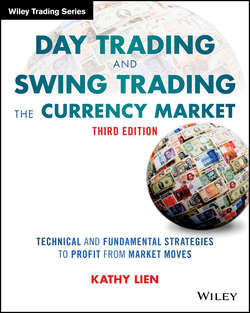Day Trading and Swing Trading the Currency Market

Реклама. ООО «ЛитРес», ИНН: 7719571260.
Оглавление
Kathy Lien. Day Trading and Swing Trading the Currency Market
Preface
About the Author
Chapter 1. Foreign Exchange – The Fastest Growing Market of Our Time
Chapter 2. Historical Events in the FX Markets
Chapter 3. What Moves the Currency Market?
Chapter 4. A Deeper Look at the FX Market
Chapter 5. What Are the Most Market Moving Economic Data?
Chapter 6. What Are Currency Correlations, and How Can We Use Them?
Chapter 7. Trade Parameters for Various Market Conditions
Chapter 8. Technical Trading Strategy: Multiple Time Frame Analysis
Chapter 9. Technical Strategy: Trading with Double Bollinger Bands
Chapter 10. Technical Trading Strategy: Fading the Double Zeros
Chapter 11. Technical Trading Strategy: Waiting for the Deal
Chapter 12. Technical Trading Strategy: Inside Days Breakout Play
Chapter 13. Technical Trading Strategy: Fader
Chapter 14. Technical Trading Strategy: 20-Day Breakout Trade
Chapter 15. Technical Trading Strategy: Channels
Chapter 16. Technical Trading Strategy: Perfect Order
Chapter 17. Fundamental Trading Strategy: Pairing Strong with Weak
Chapter 18. Fundamental Trading Strategy: The Leveraged Carry Trade
Chapter 19. Fundamental Trading Strategy: Macro Event Driven Trade
Chapter 20. Quantitative Easing and Its Impact on Forex
Chapter 21. Fundamental Trading Strategy: Commodity Prices as a Leading Indicator
Chapter 22. Fundamental Strategy: Using Bond Spreads as a Leading Indicator for FX
Chapter 23. Fundamental Trading Strategy: Risk Reversals
Chapter 24. Fundamental Trading Strategy: Using Option Volatilities to Time Market Movements
Chapter 25. Fundamental Trading Strategy: Intervention
Chapter 26. Currency Profiles and Outlook
Chapter 27. Currency Profile: Euro (EUR)
Chapter 28. Currency Profile: British Pound (GBP)
Chapter 29. Currency Profile: Swiss Franc (CHF)
Chapter 30. Currency Profile: Japanese Yen (JPY)
Chapter 31. Currency Profile: Australian Dollar (AUD)
Chapter 32. Currency Profile: New Zealand Dollar (NZD)
Chapter 33. Currency Profile: Canadian Dollar (CAD)
Index
WILEY END USER LICENSE AGREEMENT
Отрывок из книги
Dedicated to My Son Jackson,
Who I Hope Will Share His Momma's Love for the Markets
.....
Analyze Stocks Like Countries
Trading currencies is not a big challenge for fundamental traders either, because countries can be analyzed like stocks. For example, if you analyze growth rates of stocks, you can use gross domestic product (GDP) to analyze the growth rate of countries. If you analyze inventory and production ratios, you can follow industrial production (IP) or durable goods data. If you follow sales figures, you can analyze retail sales data. As with a stock investment, it is better to invest in the currency of a country that is growing faster and fund it with a currency of a country that is growing slower. Currency prices reflect the balance of supply and demand for currencies. Two of the primary factors affecting supply and demand of currencies are interest rates and the overall strength of the economy. Economic indicators such as GDP, foreign investment, and the trade balance reflect the general health of an economy and are therefore responsible for the underlying shifts in supply and demand for that currency. There is a tremendous amount of data released at regular intervals, some of which are more important than others. Data related to interest rates and international trade is the most closely followed.
.....